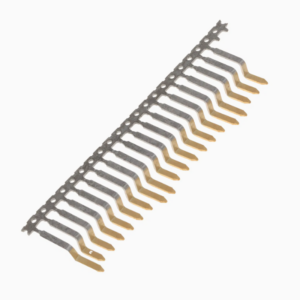Busbars
Busbars, made of copper, brass, or aluminum, serve as conductive metal strips with grounding capabilities, offering greater flexibility in power distribution compared to other forms. With the growing electric vehicle market, we also offer customized busbars for tailored power transmission to meet diverse electrical system needs. Busbars play a critical role in collecting, controlling, and distributing current for efficient and safe power transmission
BUSBAR APPLICATIONS
Fundamentally, bus bars serve as conduits for consolidating input currents and channeling them towards output circuits. Serving as the intermediary link between input and output power, these components typically consist of stamped conductive material, predominantly copper. Tailored to various electrical configurations, bus bars offer the advantage of minimizing maintenance, labor, and installation expenses. Their swift and straightforward connectivity and installation processes render them indispensable across diverse environments, including:
Data centers
Automobiles (ICE & EV)
Industrial facilities
Batteries
EV AC invertor (automotive)
Battery pack
Fuse panel
Circuit breaker
Charging inlet
DC-to-DC converters
AC-to-DC converters
Heaters
Air compressors
Power converters
Power inverters
Batter Disconnect Units (BDU)
Junction Box
Advantage of Busbars
In comparison to traditional cables, bus bars offer a multitude of advantages in terms of design, efficiency, safety, and performance:
Enhanced design flexibility: Bus bars provide a range of interconnection styles adaptable to various interfaces, enhancing overall design versatility.
Enhanced efficiency: By facilitating all necessary connections between components, bus bars contribute to increased system efficiency.
Enhanced reliability: Bus bars mitigate the risk of wiring errors and potential points of failure, thereby enhancing overall system reliability.
Increased capacitance: With higher capacitance levels, bus bars aid in noise suppression, contributing to improved system performance.
Cost-effectiveness: Utilizing fewer materials and simplifying installation and maintenance processes, bus bars help lower overall costs.
Efficient heat dissipation: Engineered for optimal airflow, bus bars can also function as effective heat sinks, further enhancing system reliability and longevity.
Environmentally friendly. Because bus bars are reusable and require fewer materials, they offer a more environmentally friendly solution compared to other power distribution options.
We use progressive die-stamping technology and machinery capable of handling specifications such as die stamping pressure ranging from 60 to 200 tons, tailored tooling transfer or staging based on part geometry, matching strip widths to part widths to reduce scrap per strip effectively, extensive capabilities for seamless handling of large coils, and offering hand-stacked packaging and customized cell packing options to ensure scratch-free parts as needed.
METAL STAMPING DESIGN FEATURES
Stamping design features include:
Bi-Metal
Coated
Compliant Pin (eye of the needle)
Countersunk Holes
Embossed
Enameled
Eyelets
Formed
Heat-Treated
IDC Slots
Injection Molded
Insert Molded
Multiple Stamping
Powder Coated
Precious Metal Plated
Threaded
Tuning Forks
Welded
POST-STAMPING OPERATIONS
In addition to our manufacturing capabilities, we provide a range of post-production processes to ensure the completion of finished parts before packaging and delivery. These operations include
Anodizing
sandblasting
painting
powder coating
plating
silk printing
brushing
polishing,
laser engraving.
MATERIALS
Aluminum
Brass
Bronze
Carbon Steel
Copper
Hardened Steel
Inconel
Iron
Nickel
Stainless Steel
Steel
Tin
Titanium
Tool Steel
PLATING MATERIAL FINISHES
We provide various pre- and post-plating options for metal stamping assemblies to allow for corrosion protection, electrical conduction, decorative use, wear resistance, coloring, bonding, and lubricity. You can choose between overall plating, select plating, or spot plating application. Plating material finishes include:
Copper
Nickel
Tin-Lead
Tin
Palladium
Palladium-Nickel
Silver
Gold
Zinc
STAMPING ASSEMBLY HARDWARE AND PART INSTALLATIONS
For assembled applications, parts may require joining of metal hardware, plastic parts or metal inserts. Examples of assembly hardware and part installations are:
Plastic Pieces
Metal Inserts
Fasteners
Screw Machine Parts
Bushings
Nuts
Studs
The Process For Packing
Carton
Wooden case
Wooden pallet
Plastic pallet
Wire basket
Woven bag
Dedication to Quality
Our unwavering commitment to quality underscores our dedication to meeting and exceeding our customers' expectations. We strive to enhance customer satisfaction by continually enhancing our products, processes, services, and quality management system. Demonstrating our steadfast dedication to quality, we employ a range of testing and inspection methodologies, including:
Failure Mode and Effects Analysis (FMEA) to prevent potential failure points.
Adherence to the rigorous Production Part Approval Process (PPAP) for stringent compliance standards.
Implement Advanced Product Quality Planning (APQP) to ensure production stability and consistency.
Moreover, our certification under ISO9001 and IATF 16949:2016 underscores our commitment to delivering precise, high-quality products, further instilling confidence in our customers



